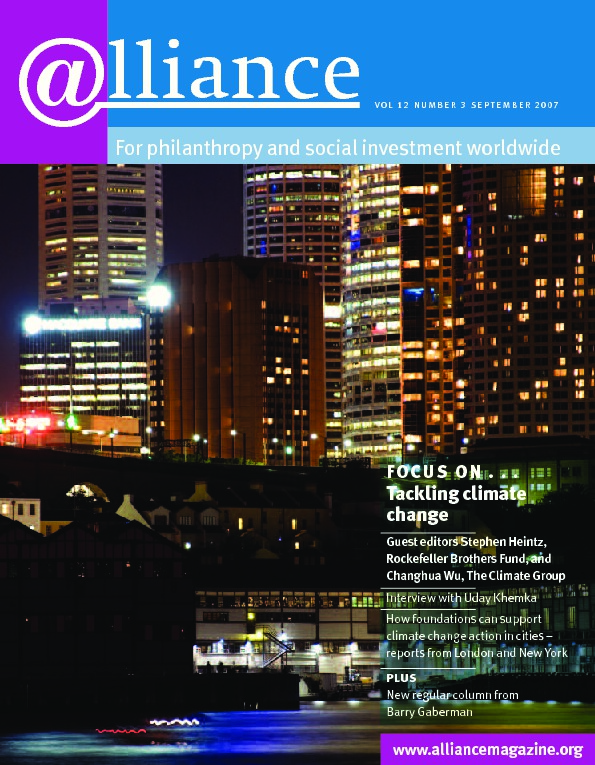Political leaders around the world are moving towards policies to combat climate change and China is no exception. In June its leaders unveiled a plan to tackle the country’s growing greenhouse gas emissions. The Climate Group has recently begun work in China and believes that the country is the key to the world’s response to climate change. This article explains how China is beginning to address the challenges of global warming and spotlights the opportunities for funding partners.
‘Climate change has become a social and environmental problem for China.’ This momentous acknowledgement by senior Chinese leaders accompanied the publication in June of China’s National Climate Change Program. It signals that the Chinese government has begun to embrace the concept of a low carbon economy and provides a point of entry for anyone keen to support Chinese efforts to build a resource-efficient and environmentally friendly modern economy. China’s goal is to lift its citizens out of poverty while breaking the historically strong link between rising GDP per person and rising consumption of energy per person.
As Ma Kai, head of China’s National Development and Reform Commission (NDRC), the government authority on climate change, said at a press conference in June: ‘In its course of modernization, China will not tread the traditional path of industrialization, featuring high consumption and high emissions. In fact we want to blaze a new path to industrialization.’ China is aiming for a ‘circular economy’ – one in which materials (and knowledge) are used to their fullest extent, and recycled wherever possible.
Climate and energy trends in China
Extreme weather and rising temperatures have had their effect on the country in the shape of 20 consecutive warm winters between 1986 and 2005, droughts in northern China, and significantly increased rain and flooding in the south and south-west. The first ever National Assessment Report on Climate Change, published at the end of 2006, predicts that by 2050 the annual average temperature in China will rise by as much as 3.3oC (5oF) and that national annual average rainfall will rise by 7 per cent. Extreme weather events will be more frequent. The report also concludes that the all-round impact of climate change on China’s natural ecosystem and socio-economic sectors could be ‘enormously destructive’.
According to some estimates, China has overtaken the US as the world’s largest emitter of carbon dioxide (although China’s cumulative contribution to climate change will not surpass that of the West for many years to come). In the ten years up to 2004, China’s annual growth rate of greenhouse gas (GHG) emissions averaged 4 per cent.
China is rapidly increasing its energy-intensive manufacturing capacity, especially in its swelling cities. Demand for energy is rising so fast that the breakneck growth in supply can hardly keep up; about 70 per cent of that energy is still coming from coal (though it is now showing a slight decrease), and outdated technologies make Chinese industries’ use of energy very inefficient. Current forecasts are that GHG emissions will continue to grow until about 2050, when they may level off and even begin to decline.
Straightforward solutions
How, then, is China to achieve its climate-friendly economic miracle? In fact, practical solutions are already to hand. In 2004, Princeton researchers Pacala and Socolow demonstrated that 15 existing technologies (eg energy efficiency, fuel-switching, renewable energy) each has the potential to prevent 1 billion tonnes a year of carbon emissions by 2050.
A recent paper from global management consultants McKinsey shows that a quarter of the actions required, including fuel efficiency and building insulation, carry no net cost – they have a positive return on investment without policy support. When it comes to renewable power and other technologies, costs decrease with use. The more quickly action is taken, the cheaper it will be. The authoritative 2006 Stern Review on the economics of climate change showed that the cost of doing nothing will be 5-20 per cent of global GDP by 2050; the price tag for stabilizing emissions at safe levels is 1 per cent of global GDP.
Carbon reduction has begun
Important first steps have already been taken in China, led by the NDRC. Despite China’s rapid rise in energy consumption, between 1991 and 2005 the country is estimated to have avoided about 1.8 billion metric tonnes of CO2 emissions through economic restructuring and energy efficiency.
Renewable energy accounted for 7.5 per cent of total energy consumption by the end of that period, and some experts believe that China has the potential to be the world’s biggest wind energy market by 2020. Forestry management and conservation also helped to avoid a further 5 billion metric tonnes of CO2 between 1980 and 2005, and by May 2007 452 Clean Development Mechanism (CDM) projects had been approved – these involve industrialized countries paying for factories or power plants that cut or avoid emissions in poorer nations in exchange for credits that help them meet their own GHG targets.
There is also much scope for public education and awareness-raising in China. A recent survey by HSBC showed that concern about climate change is higher than the global average, with climate change selected as the number one concern above other world issues. Translating this awareness into positive action at an individual level is a significant challenge for the future.
With China undergoing such massive modernization, an unprecedented opportunity exists to move to a lower carbon pathway. But with 150 million Chinese still living on less than US$1 a day, and the average Chinese carbon footprint still barely one sixth that of the average American, China is still resistant to the idea of setting a timetable for a specific GHG reduction target. The country holds fast to the terms of the 1992 UN Framework Convention on Climate Change (UNFCCC), which stressed that reversing global warming should not mean a stark choice for developing countries: prosperity or protecting the climate.
Supporting change
Private donors can play a key role in supporting innovative ideas and solutions in the region. The most important work to be done involves mainstreaming climate change mitigation efforts in the overall national strategy. As has been illustrated, the central government is receptive to the issue, but at the moment its first priority is political stability, followed by economic growth.
Ensuring that its third priority, the environment, is viewed as a prerequisite for the first two to be achieved is vital. Specific breakthrough points for achieving this include making the case for energy efficiency and pollution control by clearly demonstrating the associated co-benefits; supporting public-private partnerships which simultaneously address environmental and economic objectives; building public awareness of the issue to strengthen the case for mainstreaming climate change mitigation at a central level; and building networks for sharing information and best practice.
Some examples of leadership already stand out: the Energy Foundation, for example, is a partnership of major US donors which has a China Sustainable Energy Programme linking Chinese experts with expertise around the world, nurturing ‘technology transfer’. Rockefeller Brothers Fund is also developing climate change programmes, focusing mainly on southern China. The Blue Moon Fund is supporting, among other things, research into CDM projects for China. Other funders that have taken on the China challenge include the Shell Foundation and the Natural Resources Defense Council.
The Climate Group’s aim is to accelerate the uptake of technology and policy solutions and build the case for leadership by supporting companies, regions and cities that are cutting greenhouse gases. Engaging Chinese business, provincial leaders and all levels of government and setting up networks for the sharing of knowledge and awareness, both nationally and internationally, are essential to meet the challenge of decarbonizing China’s growth.
With a booming economy, rapidly expanding energy needs, and ambitious goals for energy efficiency and renewable energy, China is key to the world’s response to climate change. The scientific evidence on climate coupled with inertia in political and economic systems mean that the window of opportunity to support action is limited. The time to act is now.
Key tips for private foundations
- Come into China with a good understanding of opportunities and challenges facing China today if you want to be noticed by Chinese decision-makers.
- Take time to find the right collaborative partners in China.
- Be strategic and innovative.
- Target step changes.
- Support policy research around climate changes.
- Support efforts that bring expertise and experience into China.
- Leave adequate space for local partners to explore and develop solutions that are practical for China.
Changhua Wu is the Greater China Director for the Climate Group, based in Beijing. Email cwu@theclimategroup.org
For more information
China Climate Change Info-Net http://www.ccchina.gov.cn/en
Clean Development Mechanism in China http://cdm.ccchina.gov.cn/english
State Meteorological Administration http://www.cma.gov.cn/english
China Renewable Energy Information Net http://www.crein.org.cn
The Climate Group http://www.theclimategroup.org
The China Sustainable Energy Programme http://www.efchina.org/FHome.do



Comments (0)